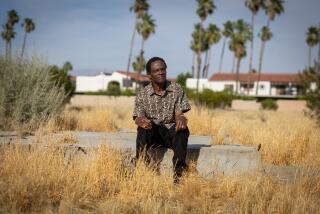Desert dust-up over demolition of tribeâs Spa Resort in Palm Springs
Tribal rights bumped up against historic preservation in Palm Springs this week, when the Agua Caliente Band of Cahuilla Indians started tearing down a 1959 spa and casino in a city that is passionate about midcentury modern architecture.
The downtown Spa Resort Casino complexâs concrete-domed entrance colonnade, which led to the propertyâs hot springs, was the first feature to be torn down in a process that will take months.
The tribe declared a sovereign right to improve the property and said it is protecting an ancient and sacred hot mineral spring.
It has not specified what those improvements will be, saying only that it is âworking to create a vision ... a masterpiece for the tourism of downtown Palm Springs.â
Stunned preservationists said the decision to do away with the colonnade was calculated to quell any additional public debate before it started.
A spokesperson for the tribe said that it held extensive conversations with the community and never promised to keep the old design.
A hotel and bath house were built between 1959 and 1963 â a collaboration among prominent modern architects William Cody, Donald Wexler, Richard Harrison and Phillip Koenig.
Peter Moruzzi, the founder of the Palm Springs Modern Committee, said the building was âamong the most sophisticated examples of midcentury modern design ever built in Palm Springs.â
It also was built on the site of an historic hot spring from which the city and the Agua Caliente Indian Reservation take their names.
Kate Anderson, a spokeswoman for the tribe, said that the mineral spring is at least 12,000 years old, dating to the ice age.
âWe are truly talking about an ancient water source that has been the heart of the tribe for thousands of years,â Anderson said. âItâs been more than 50 years since the tribe has been able to make any investment in protecting and preserving that spring, and to do so the tribe needed to make investments in the property that houses that spring.â
Preservationists were hoping that investment would incorporate key elements of the original design. They tried to convince the tribe that it could benefit from historic preservation tax credits of between 20% and 40%.
Moruzzi said the Modern Committee sat down with the tribe on July 18 and presented a comprehensive marketing package that was âcompletely supportive of their plans.â
It included information on the tax credits as well as ideas to âmeet their financial goals for a newly revised, high-end hotel with higher occupancy that was based on the midcentury heritage of the city.â
He said that the tribe said it would take months to decide what to do with the property.
He shared a screenshot that he took of the tribeâs Vision Agua Caliente website that states, âIn July 2014 we closed our downtown Palm Springs hotel and began the lengthy process of creating the vision and identifying the necessary steps to preserve this key landmark in downtown and rejuvenate the property around it.â
Moruzzi had no idea demolition was scheduled until a colleague texted him about it on Wednesday morning. He wasnât the only person caught off guard.
Palm Springs City Councilman Paul Lewin told the Desert Sun that he personally asked for the preservation of the colonnade at a joint meeting of city and tribal councils this summer. âThe tribal chair said that he would reach out to us prior to doing anything,â Lewin told the paper, âAnd Iâm very disappointed to learn about this as well.â He could not be reached for comment Friday afternoon.
Anderson said that after the property closed on July 8, the tribe conducted an extensive artistic, historical and cultural review. Based on that evaluation, âthe Tribe carefully removed and is storing numerous art pieces that include, but are not limited to, paintings, all sculptures, baskets, signs, graphics, mosaic and ceramic tiles, light fixtures, sculptured door handles and varied pieces of memorabilia.â
âWe met and listened to tribal members, community leaders, members of the public and preservationists. We took all their comments and submittals into serious and respectful consideration,â Anderson wrote in an email. âThe results of this exhaustive process led us in our current direction. The responsibility of creating a vision requires making tough decisions.â
That does little to soothe the disappointment of preservationists who feel that itâs a tragic loss for a city that has become famous for its midcentury architectural heritage.
âLike so many people I know who love the city and the architecture, this was important, this was on the par with losing the [Richard Neutra designed] Maslon house a decade ago,â said Gary Wexler, son of architect Donald Wexler. âWhen I spoke to my father he said he was heartbroken. For 55 years the colonnade was a tribute to the location and site. It was a respectful and elegant experience and people worldwide appreciated it. Itâs going to be missed.â
Follow me on Twitter @jessicagelt
More to Read
The biggest entertainment stories
Get our big stories about Hollywood, film, television, music, arts, culture and more right in your inbox as soon as they publish.
You may occasionally receive promotional content from the Los Angeles Times.











